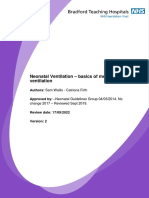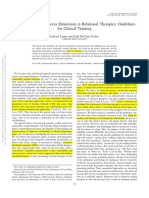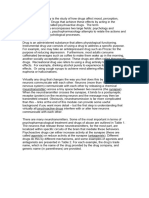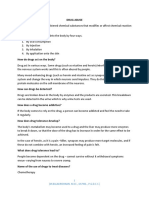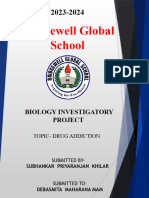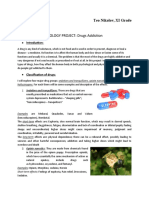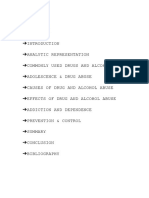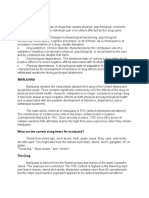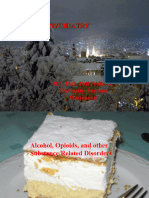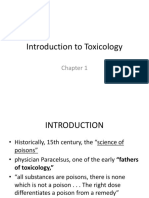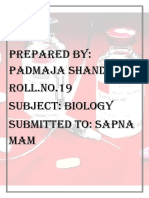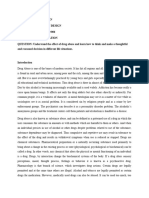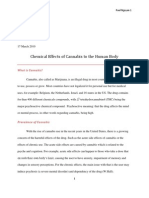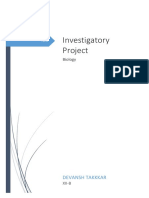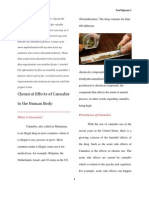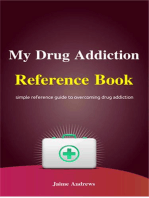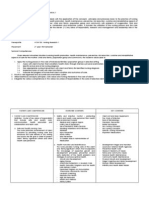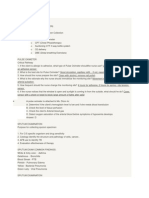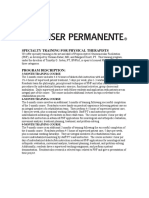Basic Principles of Drug Action
Basic Principles of Drug Action
Uploaded by
Gab PinedaCopyright:
Available Formats
Basic Principles of Drug Action
Basic Principles of Drug Action
Uploaded by
Gab PinedaCopyright
Available Formats
Share this document
Did you find this document useful?
Is this content inappropriate?
Copyright:
Available Formats
Basic Principles of Drug Action
Basic Principles of Drug Action
Uploaded by
Gab PinedaCopyright:
Available Formats
Basic Principles of Drug Action
Drugs are usually administered in one of four ways by oral ingestion, by injection, by inhalation, or by absorption through the mucous membrane of the nose, mouth or rectum. The route of administration influences the rate at which and the degree to which the drugs reaches its site of action in the body ORAL INGESTION. The oral ingestion is the preferred rout of administration for many drugs. Once they are swallowed; drugs dissolve in the fluids of the stomach and carried stream. However, some drugs readily pass through the stomach wall. (e.g. alcohol) and these take effects sooner because they do not have to reach the intestine to be absorbed. The two main advantage of the oral route of administration over other routes are its ease and relative safety. Its main advantage is its unpredictability; absorption from the digestive tract into the bloodstream can be greatly influenced by such difficulty to gauge factors as the amount and type of food in the stomach. INJECTION. Drug injection is common in medical practice because the effects of injected drugs are strong, fast, and predictable. Drug injection are typically made subcutaneously (SC) , into the fatty tissue just beneath the skin; intramuscularly (IM), into the large muscle or intravenously (IV), directly into veins at points where they run just beneath the skin. INHALATION. Some drugs can be absorbed into the bloodstream through the rich network of capillaries in the lungs. Many anesthetics are typically administered by inhalation, as are tobacco and marijuana. The two main shortcomings of this route are that it is difficulty to precisely regulate the dose of inhaled drugs, and many substance damage the lungs if they are inhaled chronically ABSORPTION THROUGH MUCOUS MEMBRANES. Some drugs can be administered through the mucous membranes of the nose, mouth, and rectum. Cocaine for example, is commonly self administered through the nasal membranes ( snorted ) but not without damaging them.
DRUG PENETRATION OF THE CENTRAL NERVOUS SYSTEM ( CNS ). Once the drug enters the bloodstream, it is carried in the blood to the blood vessels of the central nervous system fortunately, a protective filter, the blood-brain barrier, makes it difficult for many potentially dangerous blood borne chemicals to pass from the blood vessels of the CNS into its neurons. MECHANISM OF DRUG ACTION. Psychoactive drugs influence the nervous system in many ways ( see Koob & Bloom, 1988 ) Some drugs (e.g., alcohol and many of the general anesthetics) act diffusely on neural membranes throughout the CNS. Others act in a more specific way: by binding to particular synaptic receptors; by influencing the synthesis, transport, release, or deactivation of particular neurotransmitter, or by influencing the chain of chemicals reaction elicited in postsynaptic neurons by the activation of their receptors. DRUG METABOLISM AND ELIMINATION. The actions of most drugs are terminated by enzymes synthesized by the liver. These liver enzymes stimulate the conversion of active drugs to non active forms a process referred to as drug metabolism. In addition some, a small amounts of some psychoactive drugs are passed from the body in urine, sweat, feces, breath, and mothers milk. DRUG TOLERANCE Is a state of decreased sensitivity to a drug that develops as a result of exposure to it. Drug tolerance can be demonstrated in two ways: by showing that a given dose of the drugs less effect than it had before drug exposure or by showing that it takes more of the drug to that drug tolerance is a shift in the dose-response curve
FIVE COMMON ABUSED DRUGS
this section focuses on the hazards of chronic use of five commonly abused drugs: tobacco, alcohol, marijuana, cocaine, and the opiates.
TOBACCO When a cigarette is smoked, nicotine the major psychoactive ingredient of tobacco and some 4,000 other chemicals, collectively referred to as tar, are absorbed through the lungs. Each year, tobacco is responsible for over 3 million deaths worldwide, and its contributes to about 20% of all deaths in western countries. About half of those smokers who do not quit eventually die from smoking- related disease. The effects of smoking a cigarette on non- smokers and smoker can be quite different. Non smoker often respond to a few puffs of a cigarette with various combinations of nausea, vomiting, coughing, sweating, abdominal cramps, dizziness, flushing and diarrhea. In contrast, smokers report that they are amore relaxed, and alert, and less hungry after a cigarette. About 70% of all people who experiment with smoking become addicted this figure compares unfavorably with 10% for alcohol and 30% for heroin. Moreover, only about 20% of all attempts to stop smoking are successful for 2 years or more. Twin studies confirm that nicotine addiction, like other addictions, has a major genetic component. The heritability estimate is about 65% The consequences of long term tobacco use are alarming Smokers Syndrome is characterized by chest pain, labored breathing, wheezing, coughing, and a heightened susceptibility to infections of the respiratory tract chronic smokers are highly
susceptible to a variety of potentially lethal lung disorders, including pneumonia, bronchitis (chronic inflammation of bronchioles of the lungs), Emphysema( loss of elasticity of the lung from the chronic irritation), and lung cancer.
ALCOHOL Approximately 104 million Americans have consumed alcohol in the last month; 13 million of these are heavy users. Over 100,000 people die each year from alcohol Related diseases and accidents. Alcohol is involved in over 3% of all deaths in the united states, including deaths from birth defect, ill health, accidents, and violence. Because alcohol molecules are small and soluble in both fat and water, they invade all parts of the body. Alcohol is classified as a depressant because at moderate to high doses it can stimulate neural firing and facilitate social interaction. Alcohol addiction has a major genetic component. Heritability estimates are about 55% and several genes associated with alcoholism have been identified. Alcohol, like many addictive drugs, produces both tolerance and physical dependence. The livers of heavy drinkers metabolize alcohol more quickly than do the livers of non drinkers, but this increase in metabolic efficiency contributes only slightly to overall alcohol tolerance; most alcohol tolerance is functional. Alcohol withdrawal often produces a mild syndrome of headache, nausea, vomiting, and tremulousness, which is a euphemistically referred to as a hangover. A full blown alcohol withdrawal syndrome comprises three phases. The First phase begins about 5 or 6 hours after the cessation of a long bout heavy drinking and is characterized by severe tremors, agitation, headache, nausea, vomiting, abdominal cramps, profuse sweating, and sometimes hallucinations. The defining feature of the second phase, which typically occurs between 15 and 30 hours after the cessation of drinking, is convulsive activity. The third phase, which usually begins a day or two after the cessation of drinking is convulsive activity. The third phase, which usually begins a day or two after the cessation of drinking lasts for 3 or 4 days, is called delirium tremens (DTs). the DTs are characterized by disturbing hallucinations bizarre delusions, agitation, confusion, hyperthermia.( high body temperature ), and tachycardia( rapid heart rate ). The convulsions and the DTs produced by alcohol withdrawal can be lethal.
MARIJUANA Marijuana is the name commonly given to the dried leaves and flowers of cannabis sativa the common hemp plant. Approximately 2 million Americans have used marijuana in the last month. The usual mode of consumption is to smoke these leaves in a joint. Or a pipe but marijuana is also effective when ingested orally, if first baked into an oil-rich substrate, such as a chocolate brownie, to promote absorption fro the gastrointestinal tract. The psychoactive effect of marijuana are largely attributable to a constituent called THC ( delta-9tetrahydrocannabinol). However, marijuana contains over 80 cannabinoids (chemicals of the same chemical class as THC), which may also be psychoactive. Most of the cannabinoids are found in a sticky resin covering the leaves and flowers of the plant; this resin can be extracted and dried to form a drak corklike material called hashish. Hashnish can be further processed into an extremely potent product called hash oil. Two adverse effects of heavy marijuana use have been well documented. First the minority of marijuana smokers who smoke it regularly tend to develop respiratory problems. Cough, Bronchitis, and Asthma. Second because marijuana produces tachycardia (elevated heart rate) single large dose can trigger heart attacks in susceptible individuals suffered heart attack. Although many people believe that marijuana causes brain damage, there is no direct evidence of brain damage in users of this substance. However, some have argued that marijuana use two behavioral effect that could be the consequence of brain damage, In neither case however, is the evidence strong. First, many people believe that marijuana use causes permanent memory loss. Rogers and robins (2001) reviewed the relevant evidence, and they reported that only two studies have found were not under the influence of the drug at the time of the study. However, there is no evidence that such memory deficits persist for more than a few days once marijuana use has been curtailed (Pope et al., 2001) Second, many people believe that marijuana causes mental illness, in particular, schizophrenia. Several correlational studies have shown that heavy marijuana users are more likely to be subsequently be diagnosed with schizophrenia. The best of years, after some of the obvious confounds had been controlled, there was a higher incidence of schizophrenia among the heavy marijuana users.
COCAINE AND OTHER STIMULANTS. Stimulants are drugs whose primary effect is to produce general increases in neural and behavioral activity. Although stimulants all have a similar profile of effects. They differ greatly in their potency. Coca-Cola is a mild commercial stimulant preparation consumed by many people around the world. Today, its stimulant action is attributable to caffeine, but when it was first introduced. the pause that refreshes packed a real wallop in the form of small amounts of cocaine. Cocaine and its derivatives are the most commonly abused stimulants, and thus they are the focus of this discussion. Cocaine is prepared fro the leaves of the coca bush, which is found primarily in Peru and Bolivia. For centuries, a crude extract called coca paste has been made directly from the leaves and eaten. Cocaine hydrochloride is an effective local anesthetic and was once widely prescribed as such as procaine and lidocaine. It is not however, cocaines anesthetic actions that are of interests to users. People eat, smoke, snort, or inject cocaine or its derivatives in order to experience its psychological effects. Users report being swept by a wave of well being; they feel self confident, alert, energetic, friendly, outgoing, fidgety, and talkative and they have less than their usual desire for food and sleep. Cocaine addicts tend to go on so called cocaine sprees, binges in which extremely high levels of intake are maintained for periods of a day or two. During the cocaine spree, users become increasingly tolerant to the euphoria producing effects of cocaine. Accordingly , larger and larger doses are often administered. The spree usually ends when the cocaine is gone or when it begins to have serious toxic effects.
THE OPIATES: HEROIN AND MORPHINE Opium - the sap that exudes from the seeds of the opium poppy several psychoactive ingredients. Most notable are morphine and
codeine, its weaker relative. Morphine, Codeine, and other drugs that have similar structure or effects are commonly referred to as opiates. The opiates exert their effects by binding to receptors whose normal function is to bind to endogenous opiates. The endogenous opiate neurotransmitters that bind to such receptors are two of two classes: endorphins and enkephalins. The opiates have a Jekyll and Hyde character. On their Dr. Jekyll side, the opiates are unmatched as analgesics (painkillers), and they are also extremely effective in the treatment of cough and diarrhea. But, unfortunately, the kindly Dr. Jekyll brings with him the evil Mr. Hyde the risk of addiction.
Early Studies of brain mechanisms of addiction: Dopamine
The positive incentive value of drug taking had been implicated in addiction, and the experience of pleasure had been linked to the mesocorticolimbic pathway. It was natural, therefore, that the first sustained efforts to discover the neutral mechanisms of drug addiction should focus on the mesocorticolimbic pathway. In considering the neutral mechanisms of drug addiction, it is important the neutral mechanisms could not possibly have evolved for the purpose of mediating addiction drug addiction is not adaptive. Thus, the key to understanding the neutral mechanisms of addiction lies in understanding natural motivational mechanisms and how they are co-opted and warped by addictive drugs. Early Evidence of the involvement of Dopamine in Drug Addiction In the 1970s following much research on the role of dopamine in intracranial self-stimulation, experiments began to implicate dopamine in the rewarding effects of natural reinforces and addictive drugs. For example, in rats, dopamine antagonists blocked the self-administration of, or conditioned preference for, several different addictive drugs; and they reduced the reinforcing effects of food. These findings suggested that dopamine signaled something akin to reward value of pleasure. The Nucleus Accumbens and Drug Addiction Once evidence had accumulated linking dopamine to natural reinforcers and drug-induced reward, investigators began to explore particular sites in the mesocoricolimbic dopamine pathway by conducting experiments on laboratory animals. Their findings soon occurring in the nucleus accumbens. Events occurring in the nucleus accumbens and dopaminergic input to it from the ventral tegmental area appeared to be most clearly related to the experience of reward and pleasure.
You might also like
- Neonatal Ventilation - Basics of Mechanical Ventilation: Authors: Sam Wallis - Catriona FirthDocument21 pagesNeonatal Ventilation - Basics of Mechanical Ventilation: Authors: Sam Wallis - Catriona FirthEduardo Rios DuboisNo ratings yet
- Chapter Four - Drug and Substance AbuseDocument49 pagesChapter Four - Drug and Substance AbuseBiruk Shiferaw100% (1)
- Drugs MeaningDocument2 pagesDrugs MeaningDaisy MaigueNo ratings yet
- Teyber2014 - Working With The Process DimensionDocument8 pagesTeyber2014 - Working With The Process DimensionSpongeBobLongPantsNo ratings yet
- BiologyDocument21 pagesBiologypraveen godara100% (1)
- Wa0001.Document16 pagesWa0001.vaibhav90percentNo ratings yet
- Submitted By:: RD THDocument25 pagesSubmitted By:: RD THMuhammad Taha SiddiquiNo ratings yet
- A Pharmaceutical Drug (Also Referred To As Medicine, Medication, or Simply As Drug) Is A D Rug Used To Diagnose, Cure, Treat, or Preven T DiseaseDocument5 pagesA Pharmaceutical Drug (Also Referred To As Medicine, Medication, or Simply As Drug) Is A D Rug Used To Diagnose, Cure, Treat, or Preven T Diseasekashmala hussainNo ratings yet
- Finals ReadingsDocument15 pagesFinals ReadingsmarasigankylaclarissNo ratings yet
- PsychopathologyDocument13 pagesPsychopathologyAafreen KhanNo ratings yet
- Substance Abuse: Substance Abuse, Also Known As Drug Abuse, Refers To A MaladaptiveDocument10 pagesSubstance Abuse: Substance Abuse, Also Known As Drug Abuse, Refers To A MaladaptiveOyedotun TundeNo ratings yet
- AnethDocument20 pagesAnethAndrewGutierrezFloresNo ratings yet
- COCAINEDocument54 pagesCOCAINEZenwel PaulaNo ratings yet
- Drug Abuse, SmokingDocument69 pagesDrug Abuse, SmokingKathleen FrancoNo ratings yet
- Drugs AddictionDocument18 pagesDrugs AddictionReader100% (2)
- Tutorial 4.4Document4 pagesTutorial 4.4Rosa FinizioNo ratings yet
- Nstp-Cwts Module 3Document4 pagesNstp-Cwts Module 3JUAN VICTOR MACADANGDANGNo ratings yet
- Mental Health 2Document45 pagesMental Health 2Shahnaz AhmedNo ratings yet
- SRISTHI MOHANTY Biology ProjectDocument14 pagesSRISTHI MOHANTY Biology ProjectSristhi MohantyNo ratings yet
- Psychoactive DrugsDocument14 pagesPsychoactive DrugspoopooNo ratings yet
- Smrati SinghDocument20 pagesSmrati Singhsmratis38No ratings yet
- Drug AddictionDocument23 pagesDrug AddictionsjvNo ratings yet
- Gateway DrugsDocument6 pagesGateway DrugsMaynard Pascual100% (1)
- 1 (M.balakrishnan. M.SC., M.phil., P.G.D.C.C.)Document8 pages1 (M.balakrishnan. M.SC., M.phil., P.G.D.C.C.)Balakrishnan MarappanNo ratings yet
- Draft 1Document5 pagesDraft 1PaulNo ratings yet
- Cannabis and Psychiatric PathologyDocument9 pagesCannabis and Psychiatric PathologyDaniela Jacob PintoNo ratings yet
- Drug ReriewDocument5 pagesDrug Reriewamayido79No ratings yet
- BIOLOGYDocument19 pagesBIOLOGYiamhardikvermaNo ratings yet
- Project Report On Drugs (Without Pics)Document12 pagesProject Report On Drugs (Without Pics)emdusty0% (1)
- Subhankar BiologyDocument21 pagesSubhankar BiologyvvdgkyezyiNo ratings yet
- Alcohol Dependency AssignmentDocument24 pagesAlcohol Dependency AssignmentRidhimaa DevlalNo ratings yet
- Drug DependenceDocument81 pagesDrug DependenceTony LiNo ratings yet
- BIOLOGY PROJECT: Drugs Addiction: Teo Nikolov, XI GradeDocument7 pagesBIOLOGY PROJECT: Drugs Addiction: Teo Nikolov, XI GradeTeo NikolovNo ratings yet
- Bio ProjectDocument21 pagesBio ProjecthrithikravindranNo ratings yet
- Mental Nursing 8Document8 pagesMental Nursing 8yousaf68h4No ratings yet
- Biology Investigatory ProjectDocument17 pagesBiology Investigatory Projectchoudharyranveer26No ratings yet
- Definitions: MarijuanaDocument4 pagesDefinitions: MarijuanaJanine Panuelos DolzNo ratings yet
- Alcohol, Opioids, and Other SubstanceDocument98 pagesAlcohol, Opioids, and Other SubstanceKesha PatelNo ratings yet
- CombinepdfDocument122 pagesCombinepdfmansour karimNo ratings yet
- Mental Health Assnt 2Document10 pagesMental Health Assnt 2Barnabas KipngetichNo ratings yet
- Prepared By: Padmaja Shandilya Roll - No.19 Subject: Biology Submitted To: Sapna MamDocument17 pagesPrepared By: Padmaja Shandilya Roll - No.19 Subject: Biology Submitted To: Sapna MamTHE TALKIESNo ratings yet
- Nicotine Related DisordersDocument74 pagesNicotine Related DisordersKuldeep singhNo ratings yet
- Substance Abuse Has Been Adopted by The DSM As A Blanket Term To Include 10 Separate Classes ofDocument6 pagesSubstance Abuse Has Been Adopted by The DSM As A Blanket Term To Include 10 Separate Classes ofsukunath0% (1)
- Drugs: What Is A Drug??Document9 pagesDrugs: What Is A Drug??Alyzza BorrasNo ratings yet
- Research in MAPEHDocument6 pagesResearch in MAPEHNiña SamsonNo ratings yet
- The Effects of Drug Abuse On UsDocument2 pagesThe Effects of Drug Abuse On UssamabansNo ratings yet
- Aisha AssignmentDocument5 pagesAisha AssignmentUmar Bello UmarNo ratings yet
- Shreya Thokal - Drug Addiction Biology ProjectDocument15 pagesShreya Thokal - Drug Addiction Biology Project28-Shreya ThokalNo ratings yet
- Chemical Effects of Cannabis To The Human BodyDocument7 pagesChemical Effects of Cannabis To The Human BodyPaulNo ratings yet
- Drug AbuseDocument23 pagesDrug AbuseStanley AnadiNo ratings yet
- Drug Addiction Causes and Remedial MeasuresDocument15 pagesDrug Addiction Causes and Remedial Measuresnitin0010No ratings yet
- Drug AbuseDocument7 pagesDrug AbuseJames UgbesNo ratings yet
- Biology Investigatory Project Class 12 - DRUGSDocument24 pagesBiology Investigatory Project Class 12 - DRUGSDevansh Takkar91% (11)
- Effects of DrugsDocument5 pagesEffects of DrugsTom Rico DivinaflorNo ratings yet
- Drugs AddictionDocument10 pagesDrugs Addictionshiv payasiNo ratings yet
- Downloaded From FILIPINO NURSES CENTRALDocument13 pagesDownloaded From FILIPINO NURSES CENTRALFilipino Nurses CentralNo ratings yet
- Macro Economics ProjectDocument9 pagesMacro Economics ProjectHasaan RaoNo ratings yet
- Drug AddictionDocument11 pagesDrug AddictionMuskan ShuklaNo ratings yet
- Inquiry Project FinalDocument9 pagesInquiry Project FinalPaulNo ratings yet
- Mental and behavioural disorders due to use of tobaccoFrom EverandMental and behavioural disorders due to use of tobaccoNo ratings yet
- Chapter 4Document57 pagesChapter 4Jaycel AquinoNo ratings yet
- Evidence-Based NursingDocument9 pagesEvidence-Based NursingKate AbadNo ratings yet
- CA 1 Resource UnitDocument8 pagesCA 1 Resource UnitPerlie Loren Arreo Cabatingan100% (1)
- Silent But Deadly - How To Spot A Sarcoma: Craig Gerrand Consultant Orthopaedic Surgeon Freeman Hospital, NewcastleDocument31 pagesSilent But Deadly - How To Spot A Sarcoma: Craig Gerrand Consultant Orthopaedic Surgeon Freeman Hospital, NewcastleAfriade yolandaNo ratings yet
- Auto-Hemotherapy Cures Goats in 15 DaysDocument7 pagesAuto-Hemotherapy Cures Goats in 15 DaysautohemoterapiabrNo ratings yet
- DoTERRA Vs Generic TermsDocument2 pagesDoTERRA Vs Generic TermsOlimpia Samoila100% (1)
- Acute BronchitisDocument2 pagesAcute BronchitisChristabella Natalia WijayaNo ratings yet
- The Libido ConceptDocument7 pagesThe Libido ConceptPaul AsturbiarisNo ratings yet
- Complementary and Alternative TherapiesDocument48 pagesComplementary and Alternative TherapiesrohamonanganNo ratings yet
- Bell Medical Catalog 202301-CompressedDocument84 pagesBell Medical Catalog 202301-CompressedMohammed AliNo ratings yet
- Malunion Delayed Union and Nonunion FracturesDocument31 pagesMalunion Delayed Union and Nonunion FracturesutisuryanjNo ratings yet
- Intramuscular InjectionDocument10 pagesIntramuscular InjectionGheorghe HotaranNo ratings yet
- Pain Assessment and ManagementDocument28 pagesPain Assessment and ManagementSawera ChNo ratings yet
- MRCP 2Document26 pagesMRCP 2riyaz414No ratings yet
- Kode SimpusDocument1 pageKode SimpusRiky PratamaNo ratings yet
- NNR Ayurvedic Hospital NashikDocument24 pagesNNR Ayurvedic Hospital NashikAfshanNo ratings yet
- 1.1 Introduction To CellsDocument46 pages1.1 Introduction To CellsAndyCho100% (1)
- Hartnup's DiseaseDocument20 pagesHartnup's DiseaseAradhanaRamchandani0% (2)
- Nursing ProceduresDocument23 pagesNursing ProceduresMeeKo Videña100% (1)
- Cholelithiasis Case StudyDocument6 pagesCholelithiasis Case StudySarah DentyNo ratings yet
- CavitationDocument13 pagesCavitationCharli Bautista100% (1)
- Obituary-Dr. Jugal Kishore 4Document3 pagesObituary-Dr. Jugal Kishore 4Rajender WahiNo ratings yet
- PNF BrochureDocument5 pagesPNF BrochuredariandNo ratings yet
- PICO Worksheet and Search Strategy Protocol: Circle OneDocument1 pagePICO Worksheet and Search Strategy Protocol: Circle Oneمجاهد إسماعيل حسن حسين100% (1)
- Domestic Accident: Group 7 Muhammad Afil Rooban Sumitha SanchiaDocument22 pagesDomestic Accident: Group 7 Muhammad Afil Rooban Sumitha SanchiaMuhmd shiyas.HNo ratings yet
- Day 1 Am PediaDocument8 pagesDay 1 Am PediaSucceed ReviewNo ratings yet
- Functional Analysis and Treatment of Inappropriate Verbal BehaviorDocument3 pagesFunctional Analysis and Treatment of Inappropriate Verbal BehaviorMariaNo ratings yet
- Healthcare Student Stereotypes: A Systematic Review With Implications For Interprofessional CollaborationDocument13 pagesHealthcare Student Stereotypes: A Systematic Review With Implications For Interprofessional CollaborationYopa YopisaNo ratings yet
